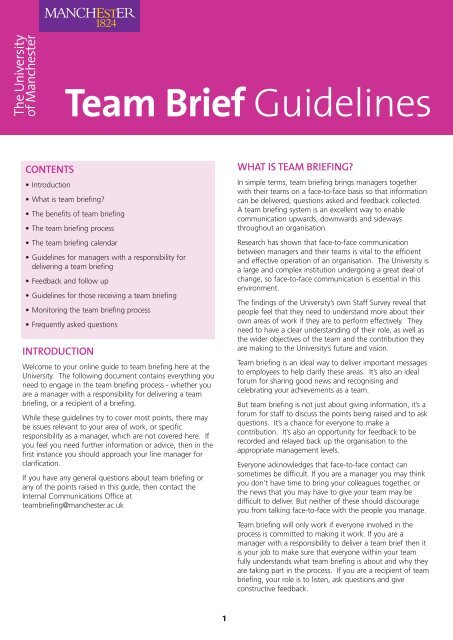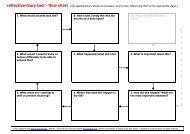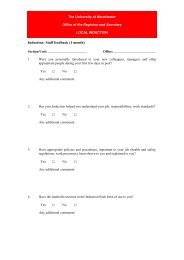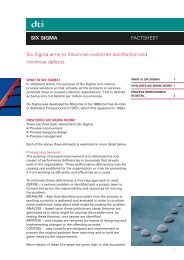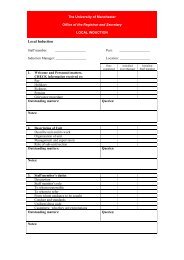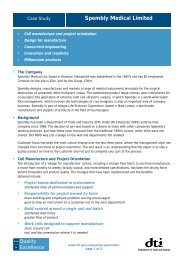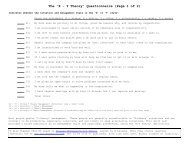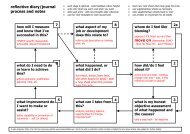Team Brief Guidelines - Businessballs
Team Brief Guidelines - Businessballs
Team Brief Guidelines - Businessballs
You also want an ePaper? Increase the reach of your titles
YUMPU automatically turns print PDFs into web optimized ePapers that Google loves.
<strong>Team</strong> <strong>Brief</strong> <strong>Guidelines</strong>CONTENTS• Introduction• What is team briefing?• The benefits of team briefing• The team briefing process• The team briefing calendar• <strong>Guidelines</strong> for managers with a responsibility fordelivering a team briefing• Feedback and follow up• <strong>Guidelines</strong> for those receiving a team briefing• Monitoring the team briefing process• Frequently asked questionsINTRODUCTIONWelcome to your online guide to team briefing here at theUniversity. The following document contains everything youneed to engage in the team briefing process - whether youare a manager with a responsibility for delivering a teambriefing, or a recipient of a briefing.While these guidelines try to cover most points, there maybe issues relevant to your area of work, or specificresponsibility as a manager, which are not covered here. Ifyou feel you need further information or advice, then in thefirst instance you should approach your line manager forclarification.If you have any general questions about team briefing orany of the points raised in this guide, then contact theInternal Communications Office atteambriefing@manchester.ac.ukWHAT IS TEAM BRIEFING?In simple terms, team briefing brings managers togetherwith their teams on a face-to-face basis so that informationcan be delivered, questions asked and feedback collected.A team briefing system is an excellent way to enablecommunication upwards, downwards and sidewaysthroughout an organisation.Research has shown that face-to-face communicationbetween managers and their teams is vital to the efficientand effective operation of an organisation. The University isa large and complex institution undergoing a great deal ofchange, so face-to-face communication is essential in thisenvironment.The findings of the University’s own Staff Survey reveal thatpeople feel that they need to understand more about theirown areas of work if they are to perform effectively. Theyneed to have a clear understanding of their role, as well asthe wider objectives of the team and the contribution theyare making to the University’s future and vision.<strong>Team</strong> briefing is an ideal way to deliver important messagesto employees to help clarify these areas. It’s also an idealforum for sharing good news and recognising andcelebrating your achievements as a team.But team briefing is not just about giving information, it’s aforum for staff to discuss the points being raised and to askquestions. It’s a chance for everyone to make acontribution. It’s also an opportunity for feedback to berecorded and relayed back up the organisation to theappropriate management levels.Everyone acknowledges that face-to-face contact cansometimes be difficult. If you are a manager you may thinkyou don’t have time to bring your colleagues together, orthe news that you may have to give your team may bedifficult to deliver. But neither of these should discourageyou from talking face-to-face with the people you manage.<strong>Team</strong> briefing will only work if everyone involved in theprocess is committed to making it work. If you are amanager with a responsibility to deliver a team brief then itis your job to make sure that everyone within your teamfully understands what team briefing is about and why theyare taking part in the process. If you are a recipient of teambriefing, your role is to listen, ask questions and giveconstructive feedback.1
TEAM BRIEF GUIDELINESTHE BENEFITS OF TEAM BRIEFING• <strong>Team</strong> briefing provides a channel for delivering clearmessages and encouraging open communication• Timely face-to-face communication prevents rumour andthe grapevine from gaining credibility• It’s a great form of two-way communication - it’s not justabout informing people, but listening and responding toquestions and concerns• It enables questions and suggestions to be fed back fromstaff to the top• It develops greater awareness and involvement at all levels• <strong>Brief</strong>ing develops a shared sense of mission, vision,collective aims and reasons why we’re here• Successful team briefing ensures that there is lessmisunderstanding within your team and other parts of theUniversity• It ensures that staff are kept up to date on performance,results, progress and policy changesTEAM BRIEFING CALENDAR<strong>Team</strong> <strong>Brief</strong>ing processinitiated:Monday 1 SeptemberMonday 6 OctoberMonday 3 NovemberMonday 1 DecemberMonday 2 FebruaryMonday 2 MarchMonday 6 AprilMonday 11 MayMonday 1 JuneMonday 6 JulyCascades/<strong>Team</strong> <strong>Brief</strong>ingscompleted by:Friday 5 SeptemberFriday 10 OctoberFriday 7 NovemberFriday 5 DecemberFriday 6 FebruaryFriday 6 MarchFriday 10 AprilFriday 15 MayFriday 5 JuneFriday 10 JulyTHE TEAM BRIEFING PROCESSAs of March 2008, a new system of team briefing for allstaff within the University’s administration, is beingintroduced.The team briefing process will begin on the first Monday ofeach month (where Bank Holidays fall on a Monday thebriefing will take place on the next available working day).On these dates (outlined in the <strong>Team</strong> <strong>Brief</strong>ing Calendar), theRegistrar will meet with his team of direct reports and give averbal Core <strong>Brief</strong>. Where it is felt necessary to support thiswith a written document, bullet points will be madeavailable.Each of the Registrar’s direct reports must nominate adeputy who can attend this verbal Core <strong>Brief</strong> session if theythemselves are unable to attend.Those managers who have received the Registrar’s verbalCore <strong>Brief</strong> should then be in a position to deliver their ownteam brief to their team of direct reports. This team briefingshould include the points from the Registrar’s Core <strong>Brief</strong>(around 30% of the content of the briefing), however themajority of the briefing should consist of local informationie: information relating to each specific function/area ofwork.These managers should then brief their own teams, againincluding the information from the Core <strong>Brief</strong> and the localbrief which they have received, and again adding anyfurther local information which they feel may be ofrelevance to their own individual team.The cascade of briefings should continue down all relevantlevels of management until all teams have received a faceto-faceteam briefing.In areas with large staff numbers it may be necessary formanagers to brief their deputies/supervisors within theseteams and ask them to continue the information cascade.In these cases deputies/supervisors should be given the teambrief produced by their manager ie: they will not be requiredto generate their own team brief.To ensure that all administrative staff receive the informationin a timely manner, all briefings should be delivered withinfive working days of the initiation of the cascade. See the<strong>Team</strong> <strong>Brief</strong>ing Calendar for further details.If you are a manager/supervisor and are unsure whether youhave a responsibility for delivering a team briefing, pleasediscuss this with your line manager. This will ensure that thecorrect cascade of information is established from theoutset.2
TEAM BRIEF GUIDELINESGUIDELINES FOR MANAGERS WHOARE RESPONSIBLE FOR DELIVERINGA TEAM BRIEFThe first thing to do is establish whether you are responsiblefor delivering a briefing to your team. This will dependupon the size of your team and the management structureof the part of the administration in which you work. If youare in any doubt as to whether you should be delivering ateam briefing, then clarify this with your line manager assoon as possible.Once you have established whether you are responsible fordelivering a team briefing, make sure that you know exactlywho you are supposed to include in your briefing.Remember when holding your first team briefing meeting toexplain to your team why you have called the briefing andwhat they can expect.The following points will help you to prepare for a teambriefing. If you feel you would benefit from some additionaltraining then you can contact the Staff Training andDevelopment Unit (STDU) at courses-stdu@manchester.ac.ukThe STDU is running a series of short workshops aimed atmanagers who will be responsible for holding teambriefings.i) ARRANGING YOUR TEAM BRIEFINGTimingFirst of all make yourself familiar with the <strong>Team</strong> <strong>Brief</strong>ingCalendar and work out when you will be expected todeliver your brief to your team. You may need to discussthis with your line manager to ensure that the correctcascade mechanism is in place.Once the cascade has been agreed, you should set a seriesof dates for your team briefings - try setting dates for atleast six months at a time so that your staff are well awareof the dates in advance and can put them into their diaries.When choosing dates you should try to aim for a day whenmost of your team is around - take into consideration thosewho may work part-time or shifts/rotas.SizeThe ideal team briefing is made up of around 4-15 people.If you are responsible for large numbers of staff then it maymake sense to identify supervisors/managers/deputies withinyour team who could deliver team briefing meetings tosmaller groups of staff. If you’re in doubt about the bestway to approach this then speak to your line manager forguidance.VenueMake sure you choose a suitable venue for your teambriefing. Take into consideration the number of people whowill be involved in the briefing and any access requirementsyour staff may have.Publicising the briefingsOnce you’ve got all the arrangements in place make surethat you give your team enough notice so that they are ableto attend. Make sure everyone knows where the venue is.If you’ve set dates for a few months in advance it’s worthletting people know about the dates all at once so that theycan plan ahead.3
TEAM BRIEF GUIDELINESii) THE AGENDAThe most important thing to remember is that no more than30% of the content of your team briefing should be madeup of items on the Core <strong>Brief</strong>. The majority of your briefingneeds to be made up of items of news from your own localarea of work. The following section ‘Preparing the Local<strong>Brief</strong>’ will tell you more about the kind of items to include.As with all meetings, it’s best to put in some preparationbeforehand. This might mean writing yourself an agenda sothat you know which items you’ll be talking about.Remember you will be delivering your brief verbally so youwant it to sound natural - not scripted. You could trywriting headings and elaborating with a few key pointsunder each heading - just to remind you what messagesyou want to get across.PrioritiesLook at the brief through your staff’s eyes. Once you’vedecided what you want to talk about sort the items into:• Must know information - details essential to the team andit’s day to day activities• Should know information - details which staff shouldknow about as a matter of course• Nice to know information - information which might notdirectly affect the day to day work of your team butwould still be useful to know aboutSequenceAre there any logical links between the various items on thebrief? Is so, put the agenda into the order which suits this.This will help you in your delivery.TimingWork out roughly how long each item should take andmake a note of this on your agenda so that you can keepan eye on the time as you work through the briefing.Remember to allow time for questions after each item.iii) PREPARING THE LOCAL BRIEFThe briefing which you deliver to your staff should be madeup of two elements - the information contained in the Core<strong>Brief</strong> from the Registrar (no more than 30% of yourbriefing) and a local brief with information relevant to yourown area of work.The Core <strong>Brief</strong>Your manager will tell you about the Core <strong>Brief</strong> which willhave been generated by the Registrar. This Core <strong>Brief</strong> willcontain items which may be of operational or strategicimportance to the administration as a whole.You should deliver this information to your team as part ofyour team briefing, however the information from the Core<strong>Brief</strong> should only make up around 30% of your teambriefing as a whole. Where possible you should try to makethe information contained within the Core <strong>Brief</strong> as relevantto your team as possible. If the information in the Core<strong>Brief</strong> is not relevant to your area of work then just mentionit but do not dwell on it.The Local <strong>Brief</strong>The majority of your team briefing should be made up oflocal information which is relevant to your team. Here aresome pointers to get you thinking about the kind of thingsto include in your local brief.A good way to think about your brief is to split it up intothe four Ps:PeoplePromotionsAppointmentsRetirements/leaversVisitorsSuccess storiesChanged locations/functionsPoints For ActionNew and ongoing projects/activitiesSpecial eventsHealth and Safety issuesBuilding worksWork standardsUpcoming deadlinesProgressFigures, returns, numbersMarketingSuccess storiesQuality issuesCompleted projects/activitiesPolicy IssuesHuman Resources policiesStudent recruitment and retention policiesHealth and Safety policy4
TEAM BRIEF GUIDELINESIf after looking at the above points you really can’t think ofmuch local information to share with your team then simplyhold a shorter team briefing meeting. It’s better to dealwith just one issue fully than speculate or waffle aboutseveral issues you don’t know much about.Good news!Don’t forget to include good news and achievements. Goodnews does exist – you just need to find it and communicateit!Context<strong>Brief</strong>ers must always remember, and if necessary remindthose that they are briefing, that the object of the exercise isto provide information. <strong>Brief</strong>ings are not designed forconsultation or negotiation. <strong>Team</strong> briefings are also not theright place to conduct ‘collective discipline’.Anticipating questionsRemember that your team brief is as much an opportunityfor your team to ask questions as it is for you to give theminformation. When you’ve decided upon your list of itemstry to think about the kind of questions your team couldask. Put yourself in their shoes and try to anticipate theirconcerns. This will help you to prepare some answers inadvance.iv) PRESENTING THE BRIEFRemember that you will be delivering your brief face-toface,so you should give some thought to how you comeacross to your team.<strong>Brief</strong>ings should be fairly informal and by all means adoptan approach which best suit’s the culture and nature of yourteam. Even though you will have put some thought andeffort into preparing your briefing, try not to script what youwant to say - it will just come across as unnatural and youmay be thrown off course if someone asks a question!What you should do however is make sure that the style ofyour briefings is pretty consistent so that staff come toknow what to expect and what their role is in the briefing.A typical briefing might look like this:• Announce the beginning of the briefing• Note taken of any absentees• The briefer goes through the items on the brief - bothCore and local• Questions arising out of the brief are asked andanswered• The briefer refers to any significant anticipatedquestions that have not been asked• Make a note of any questions raised which you haven’tbeen able to answer• Remind the group of the date of the next meetingPoints about your presentation styleRemember that you are not addressing the United Nations!This is your own team so the briefing should be relaxed andreasonably informal.Try to be:Clear – avoid unfamiliar technicalities, acronyms, names<strong>Brief</strong> – don’t ramble, sometimes you should repeat themessage to make sure it sinks in, but do it conciselyInteresting – be interested! Use examples that the groupwill recogniseIn control – arrange the group so that you are its focus.Watch the reaction you are getting as you go alongPositive – watch out for the habit of excessiveapologising. It makes you appear nervous and it can giveyour staff the impression that you don’t really agree withdecisions which have been made at a higher level.Remember that as a manager it is your responsibility tocommunicate decisions to your team regardless of yourown personal views, so don’t try to distance yourself fromthe brief. Wherever possible arm yourself with the reasonswhich lie behind the information you are giving out5
TEAM BRIEF GUIDELINESFEEDBACK AND FOLLOW UPIf you are a manager with a responsibility for delivering ateam briefing, as soon as you have completed the briefingthere are some simple, but vital steps which you must takewith regards to feedback and follow up.These include:Records of notesIf you have taken any notes during the briefing then filethem appropriately. You can use the form in Appendix One- Recording of Notes of this document to help you. Thismay help you when you come to prepare your next briefing.What to do with feedbackAll being well, your team should have given you somefeedback and suggestions about the items you’ve beendiscussing. Make a note of the questions/ideas which cameup at the meeting and put these with your briefing notes.You can download the form in Appendix Two - RecordingFeedback to help you with this.This is especially important if you were asked a questionand couldn’t provide a full answer at the time. Make arecord of these questions and ensure that you follow themup and get back to the team. You should try to get back toyour team with an answer within ten working days of thebrief taking place. If your team briefings are to worksuccessfully it’s essential that you get back to your teamwith answers to their questions, otherwise they may start tolose faith in the whole process.Inform your line managerIt’s important that you give the feedback you receive to yourline manager so that they can feed any points they feel arerelevant back up the management chain to senior levels ifappropriate.It’s worth getting into the habit of using the feedback formto produce a short outline of any feedback which you canthen deliver to your line manager soon after the briefingmeeting so that the information is fresh in your mind. Youcan also share with your manager how you felt the briefingwent and what the level of interest was.Make sure you do your follow up quicklyIf you do this simple follow up within an hour of two of thebriefing it will take you perhaps ten minutes. If you leave ita week the chances are you won’t be able to do it at all!GUIDELINES FOR THOSE RECEIVING ATEAM BRIEFINGWhatever your role within the administration, or your levelof seniority, you will at some point be a recipient of a teambrief. Some recipients will of course also be in a positionwhere they will have to deliver a team briefing from theinformation they themselves are receiving.Before you attend your team briefing, take a few minutes tothink about the following points:Before the briefing:Do you know who will brief you?Do you know when your team briefing will be taking place?How long will the meeting take?Do you know where the team briefing will take place?Are you expected to do any preparation/bring anything withyou to the meeting?Look through the records of the last brief you received - arethere any items still outstanding?Are you having problems with the mechanics of the teambriefing which you’d like to raise with yourmanager/colleagues?At the briefing:Concentrate and listen so that you hear the brief and thequestions asked by other peopleMake concise notesAsk questions to clarify the information you have beengivenIf you’re expected to deliver a team brief to your own teammake sure you understand which points are of particularrelevance to your area of workBy the end of the briefing you should have:A clear picture of the information you have receivedAn idea of when you can expect to receive moreinformation from your manager if they weren’t able toanswer your question there and then at the briefingMONITORING THE TEAM BRIEFINGPROCESSIt’s important that the team briefing system is monitored toensure that it is working effectively. Managers at a seniorlevel should make every effort to ‘sit in’ on team briefingswithin their area of work from time to time to assess howsuccessful team briefing is.The Internal Communications team will also carry outperiodic research into the distribution and effectiveness ofteam briefing.6
TEAM BRIEF GUIDELINESFREQUENTLY ASKED QUESTIONSHow often should I hold a team briefing<strong>Team</strong> briefing meetings need to be held on a planned andregular basis. If you are a manager who will be delivering ateam brief make sure that you are aware of the <strong>Team</strong><strong>Brief</strong>ing Calendar and plan your team briefing meetingsaround this, in discussion with your line manager or fellowmanagers. Please be aware that the cascade of briefingsshould be completed within five working days of theRegistrar initiating the team briefing process.How long should my team briefing last?Your briefing should last around 30 minutes. If there isn’tmuch information to impart then don’t waffle - just reducethe length of the team briefing. Make sure you leaveenough time for staff to ask questions - this is a two-wayform of communication.How many people should there be in a team briefing?Ideally between 4 and 15 people. If you are part of a verylarge team you may need to look at the way you structureteam briefings. Perhaps you can delegate responsibility todeputies/supervisors who could deliver a brief to a smallergroup of team members? Discuss this with your linemanager if you’re in any doubt.My team is geographically dispersed and it would be hardto get them all together for a 30 minute meeting. Whatshould I do?Even though staff are geographically dispersed it’s still likelythat you will meet with them at least once a month for ateam or operational meeting. If this is the case you couldtry carrying out the team briefing at the same time ie:before the operational team meeting. You should makesure that you make the distinction between the teambriefing and the operational meeting so that attendees areclear what is going on. You should endeavour to ensurethat the team briefing takes place within the five-daytimescale outlined on the team briefing calendar. This maymean that you need to rearrange your team/operationalmeetings to coincide with this timescale. This timescale hasbeen set in advance to help you plan your meetings. <strong>Team</strong>briefing is intended to be flexible enough to accommodateeven the most extreme of situations.I am responsible for front line staff and I can’t just shutdown essential services to call a team briefing meeting.What should I do?Try to arrange your team briefing at a time when themajority of your team can attend. If however there aremembers of the team who can’t leave their post you couldlook into arranging cover for half an hour so that they canattend. If this is not possible, you may have to brief thesemembers of staff separately.What should I do about briefing absentees?You should make sure that those who are unable to attendthe team briefing still receive the information which wasdiscussed and are given an opportunity to contribute or askquestions. This may mean that you have to speak to themindividually when they are back at work. You should try todo this as soon as they are available so that the briefingcascade is completed.What should I do with the feedback I receive?With any luck your team will give you some useful feedbackand make some valid suggestions during your team briefing.It’s really important that you do something constructive withthis feedback - your team will quickly tire of the system ifthey feel their views are not being taken seriously. Use theonline forms available here to download feedback forms.Make sure you fill them in and give the feedback to yourline manager so that it can be fed higher up themanagement structure if this is appropriate.I’m not very confident doing face-to-face briefings - can Iget some training?The Staff Training and Development Unit is offering someshort workshops on team briefing. Email coursesstdu@manchester.ac.ukfor more details.7
APPENDIX ONE<strong>Team</strong> <strong>Brief</strong> - Recording of Notes<strong>Brief</strong>ing <strong>Team</strong>:Date of briefing:Prepared by:<strong>Brief</strong>ing point:Additional information/notes:<strong>Brief</strong>ing point:Additional information/notes:<strong>Brief</strong>ing point:Additional information/notes:<strong>Brief</strong>ing point:Additional information/notes:
APPENDIX TWO<strong>Team</strong> <strong>Brief</strong> - Recording Feedback<strong>Brief</strong>ing <strong>Team</strong>:Date of briefing:Prepared by:Unanswered questions from this brief:Remember it is your responsibility to report back answers to these questions.Questions should be answered within 10 working days.Item of most interest:Positive suggestions made:What does the team want to know more about in future briefs:J1919 02.08


